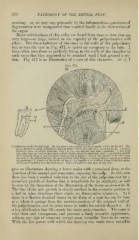Page 866 - My FlipBook
P. 866
876 PATHOLOGY OF THE DENTAL PULP.
covering—or, we may say, primarily by the inflammation — processes of
degeneration were inaugurated that resuhed finally in the destruction of
the organ.
Many calcifications of this order are found from time to time that are
very large—as large, indeed, as the capacity of the pulp-chamber will
allow. But the attachment of the mass to the walls of the pulp-cham-
ber, as was the case in Fig. 471, is rather an exception to the rule. I
have often seen these so perfectly fitting to the walls of the chamber in
such cases that they appeared to be attached until I had ground a sec-
tion. Fig. 472 is an illustration of a case of this character. At A, I
Calcification of the Dental Pulp. At A is shown tliu outline ot .i low ei molar w itb a cavity at 6. Tlie
pul|j-chamber is much reduced in size and filled with calcific material, iis shown in B. n. a large
granular mass of calciiic material, which is very transparent, but finely granular. A few very
irregular lines are seen in the centre, which slightly resemble dentinal tubes ; /;, an erratic growth
of irregularly formed and unusually transparent dentine; c, line of the growth of dentine from
the floor ol the pulp-chamber: the growth from other directions is so perfectly regular as to leave
no markings; '/, margin of the cavity of decuy ; f, a bundle of cylindrical forms of calcific mate-
rial extendiiig down into the root-canal. 1 hese extended to the apex of the root.
give an illustration showing a lower molar with a proximal decay at the
junction of the enamel and cementum, exposing the pulp. In this case
there has been a marked reduction in the size of the pulp-chamber by a
secondary growth of dentine that is remarkable for its regularity, as will
be seen by the inspection of the illustration of the tissue as shown in B.
The line of the new growth is clearly marked in the rootwise portion at
e, but in other directions there exists no demarcation whatever. At b
there is a distinct dentinal tumor in the form of a spur having its base
at c, where it springs from the rootwise portion of the original wall of
the pulp-chamber, and its point turns in under the calcific de])osit (f. At
a is a calcification that fills nearly the entire pulp-chamber. The mass is
very clear and transparent, and presents a finely granular appearance,
Avithout any sign of structure except some irregular lines in its centre.
With the low power with which the drawing was made these resemble


